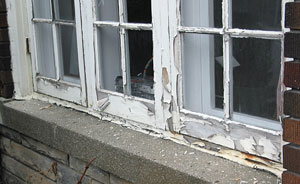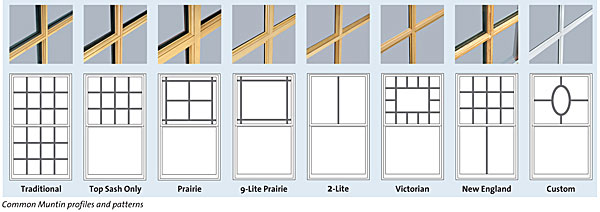Window Replacement Solutions for Commercial and Institutional Buildings
Modernizing existing buildings with new manufactured windows to improve energy efficiency, lower maintenance, and enhance design.
This course is no longer active
Sponsored by Pella and EFCO
 |
Window deterioration Photo courtesy of Pella Corporation |
Replacing windows or adding new windows to an existing building may also be appropriate for the following reasons:
- Design for Missing Historic Features: windows that have been previously removed, filled in, or deteriorated inconsistently in a building need to be addressed. The best approach is usually to provide new replacement windows that match as closely as possible the existing windows in the rest of the building.
- Alterations/Additions to Historic Buildings: a legitimate alteration or addition to an older or historic building is allowable under the Rehabilitation Guidelines but the style may or may not be an issue. In most cases it is preferred that any building additions or substantive alterations are compatible in style with the existing but can clearly be discerned as constructed at a different time. Hence the preference in this case will be to have new windows that do NOT match exactly, but are aesthetically compatible instead.
- Energy Retrofitting: meeting contemporary energy needs is an increasingly common reason to replace windows. This applies to the glass and window unit as much as to the cavities around the windows to increase overall R-values and decrease air infiltration. Some of the energy improvements may be visible, while many, such as insulating around window frames and adjacent wall cavities, may not be.
- Health and Safety Code Requirements: Changes in codes may dictate changes in the windows to comply with provisions not in effect when the existing windows were installed. Further, once a building is substantially renovated beyond a certain level or if the occupancy changes, the entire building may no longer be "grandfathered" and will need to be made fully compliant with all current code provisions, including window requirements.
Window Replacement Design Issues

Once the decision is made to replace rather than pursue repair of the windows, then some fundamental design decisions need to be considered.
- Pattern and Size: The pattern and size of openings are the most visible aspect of the windows. Generally, keeping the same pattern of openings is seen as desirable, but there may be reasons to change the sizes to be either larger or smaller. Conversely, there may be reasons to consider keeping the size identical in all respects to the existing.
- Type: Window type is a fundamental choice. The decision to keep the same style as existing or change to another such as double hung, single hung, casement, awning, fixed or other types best suited to the rehabilitated building need to be determined.
- Materials: Window unit materials for commercial and institutional buildings include not only aluminum and other metals, but increasingly wood, aluminum clad wood, fiberglass, or all vinyl windows are being used based on the preferred characteristics of those materials.
- Proportions: Window proportions of the overall window unit and the individual components such as frame & sash determine a great deal of the look and aesthetic of the windows in the building, both inside and out.
- Muntins: Muntin patterns & profiles vary notably as does the rationale to include them or not as part of the design. Historical considerations or general design appearance may require them, but energy concerns may seek to minimize them. Many window manufacturers offer choices that include muntins placed over both sides of double glazing with spacers between the glass to simulate historic profiles yet minimize the interruptions in the glass and potential air and water leakage points.
- Structure: Structural performance of the window units, including wind and storm resistance, may influence the selection of window type, materials, and size of units.
- Trim: Exterior & interior trim can, in many cases, be saved and re-used, even if the rest of the window unit is being replaced. When the exterior trim is beyond repair, a wide variety of new trim solutions are available.
- Glazing: Glass type needs to be considered not just related to the layers of glazing, but to the color, tint, reflectance and other properties. Similarly the strength and code requirements may dictate the use of glass that is tempered, laminated, or with other properties.
- Operation: Ease of operation of the window unit by building occupants can be a determining factor in replacement window selection, particularly in larger window units.
- Noise: Acoustic control in urban or airport locations will often be a factor suggesting that tight sealing and perhaps inoperable windows may be preferred in certain cases.
- Energy: Energy efficiency applies to the entire window unit, not just the R-value of the glass. In reviewing manufacturers' technical information on windows, look for the overall tested energy ratings and compare the results among manufactured units to be sure the specified units will meet the intended performance criteria.
- Budget: The overall budget needs to take into account the labor costs to install the replacement window, not just the cost of the materials. Just as some manufactured window units can be more expensive than others, some installation methods can also vary the cost. Replacement window systems that allow for installation from inside the building eliminate the need for lifts and equipment on the exterior, thus saving money on the installation.
Using the above as a basis, then the first fundamental decision to reach is whether to undertake complete tear outs of the existing window sash and frames or retain the frames and trim and replace only the sash inside the existing opening.
Originally published in Architectural Record
Originally published in January 2012









